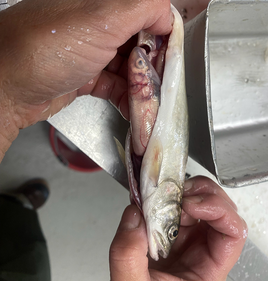
Lake Superior cisco haul!
We've consulted our crystal ball and all we see are cisco (a.k.a., herring, tullibee)!
In case you missed it, Minnesota DNR fisheries biologists at the Lake Superior office were excited to hear from our partners at the USGS Great Lakes Science Center that recent bottom trawl surveys are pulling up epic numbers of juvenile cisco.
The number of one-year-old cisco in a haul is a huge indicator of the future adult population. Once cisco successfully reach one year of age, they’re likely to make it to adulthood (three years of age) and can live to over 30 years old.
Age one cisco have been hard to come by in recent years, with some years only yielding a single fish during trawl surveys around all of Lake Superior. Scientists on the USGS Research Vessel Kiyi haven't seen numbers this high since at least 1984 and if high catches keep up, this may be a record-setting year.
Cisco are an important prey fish for larger predator fish, like lake trout. In recent years, Lake Superior hasn’t had as many prey fish for larger predator fish to eat. A boom in cisco is great news for the whole ecosystem.
Based on these findings, fisheries biologists can predict a large increase in adult numbers in three years in the commercial, sport and tribal fisheries (and maybe larger-sized predator fish!), making the USGS bottom trawl survey one of the most important surveys our federal partners do to support management across Lake Superior.
While the long, snowy winters were tough for Minnesotans the past two years, it may have been a boon for cisco. Colder water temperatures in the spring of 2022 may have allowed cisco egg hatching and zooplankton production (the tiny organisms they eat as young fry) to match up well for the first time in years.
Learn more about Lake Superior fisheries on the DNR website.
Photo courtesy of USGS Great Lakes Science Center
|